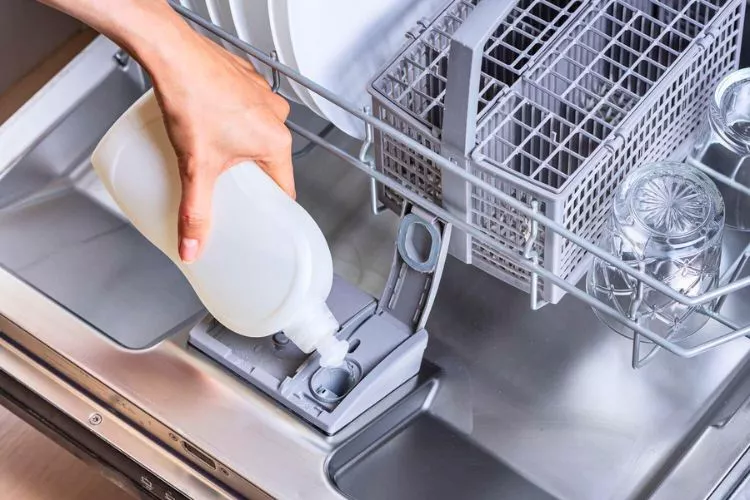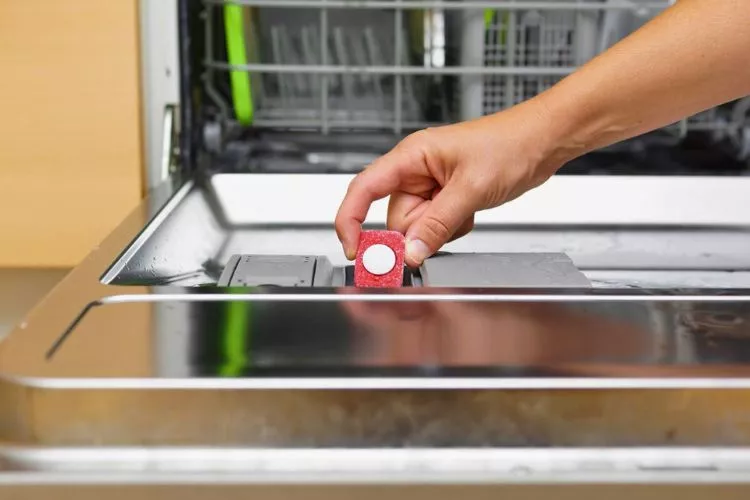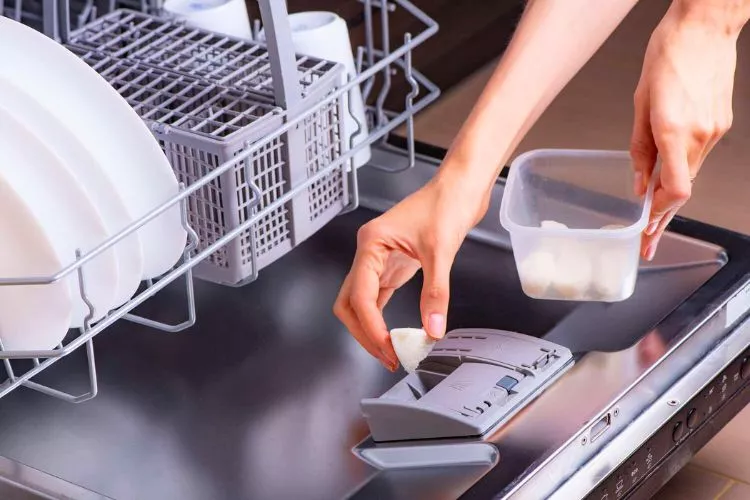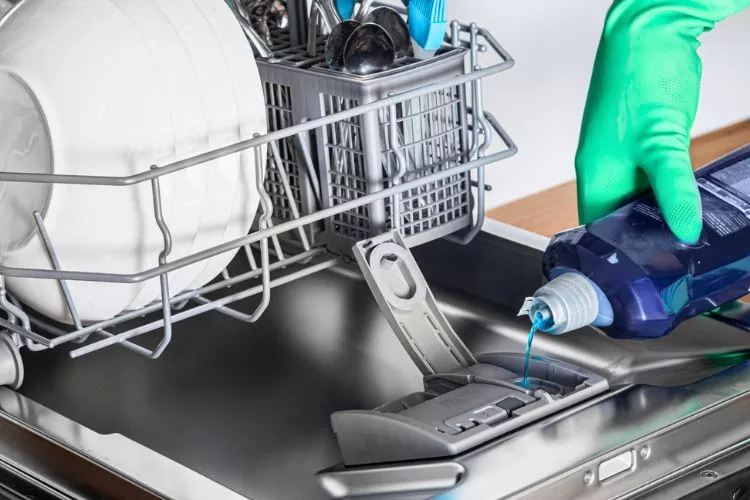We’ve all been there; you’ve just finished running your dishwasher, eagerly anticipating sparkling clean dishes, but instead you’re greeted with a sight no one likes to see i.e. soap still in dishwasher after cycle.
Frustrating, isn’t it? This rather common issue has several possible reasons, ranging from simple mistakes to more complex underlying causes.
In this article, we dive into dishwasher troubleshooting to help you identify the root cause and find the best solution for a more efficient and satisfying cleaning experience.

Quick Recommendations
Last update on 2025-08-01 / Affiliate links / Images from Amazon Product Advertising API
What to do if Soap still in dishwasher after cycle?
Sure thing! If soap remains in the dishwasher after a cycle, there are several steps you can take to solve the problem.

- Check the Dishwasher Soap Dispenser: Ensure it’s not clogged. If it is, clean out any leftover detergent or debris. In addition, inspect the latch mechanism of the dispenser to confirm it’s operating correctly.
- Verify Dish Loading: Overcrowded or improperly loaded dishes can block the soap from properly dispensing.
- Inspect the Spray Arms: Blocked spray arms can prevent water from reaching the soap dispenser. Check and clean the spray arms from any obstructions.
- Examine the Detergent: Old or clumpy detergent may not dissolve well. Use fresh, high-quality dishwasher soap.
- Assess Water Temperature: If the water isn’t hot enough (at least 120°F), the soap may not dissolve. Test the water temperature and adjust if necessary.
- Consult a Professional: If all else fails, consider getting help from a repair professional.
Troubleshoot
- Confirming the Suitability of Dishwasher Soap: First and foremost, review the type of soap you’re using. Only detergents specifically designed for dishwashers should be used. Regular dish soaps or detergents can produce too much foam, preventing complete rinsing and leaving soap residues.
- Investigating the Water Inlet Valve: The valve allows water into the dishwasher. If it’s clogged or defective, it may result in an insufficient water flow, leaving soap undissolved. Clean the valve if clogged or consult a technician if replacement is needed.
- Assessing the Water Temperature: Hot water is critical to break down and dissolve the detergent. If the water temperature is below 120°F, the dishwasher soap may not fully dissolve. Check your water heater settings and adjust if necessary.
- Examining the Dispenser Door: The soap dispenser door should open during the wash cycle to release the detergent. The soap will not be deployed properly if the door is stuck or broken. Confirm the dispenser door is in good working condition.
- Inspecting the Circulation Pump: The pump circulates water in the dishwasher, helping to distribute the soap. If it’s faulty, the detergent won’t circulate effectively. You might need help from a professional to replace a problematic pump.
- Evaluating the Spray Arm(s): The spray arms spray water (and soap) over the dishes. Blocked spray arms can prevent soap from properly dissolving and being dispersed. Regularly remove any debris and ensure they are not obstructed.
Solution
Having trouble with your dishwasher soap dispenser? Here are some potential issues and their solutions:
- Dealing with a Dysfunctional Spray Arm: Sometimes the spray arm may malfunction, hindering the proper distribution of soap in the dishwasher. Inspect the spray arm to ensure it rotates freely and emits water effectively during the cycle.
- Clearing Clogged Openings: Over time, small food particles and soap residues can clog the openings in the dispenser. Check these openings for visible blockages and clean them with a small brush or toothpick.
- Addressing a Damaged Spray Arm: If the spray arm has been damaged or broken, it must be replaced. You can often order the part online or through your dishwasher’s manufacturer, and replace it using the appliance manual for guidance.
- Removing Objects Jammed in the Lower Assembly: Objects can sometimes get stuck in the lower assembly, preventing the soap dispenser from operating properly. Always ensure no utensils or dish fragments are obstructing the mechanism.
- Ensuring Dishes Do Not Obstruct the Spray Arm: Inappropriately loaded dishes can block the spray arm. This prevents the soap from being sprayed evenly on all dishes. Make sure to load your dishes properly.
- Resolving Issues with the Temperature Sensor: An incorrect temperature reading can mean the dishwasher cycle settings aren’t activating correctly, leaving soap undissolved. Check if the dishwasher’s temperature sensor is functioning correctly, and consider getting it fixed or replaced if it’s faulty.
Whirlpool dishwasher soap not dissolving: Reason and Solution
If you’re facing the problem of the soap not fully dissolving in your Whirlpool dishwasher, it can be down to a few common reasons. Let’s explore these issues and identify the solutions.

Water Temperature Insufficiency
- Reasons: The soap may not dissolve properly if the water isn’t hot enough. The recommended water temperature for most dishwashers is around 120°F.
- Solution: Check the hot water temperature at your faucet with a thermometer. If it’s less than 120°F, you may need to adjust your water heater settings.
Dispenser Issue
- Reasons: Another common problem could be with the dispenser. If the soap dispenser lid is not opening during the wash cycle, the soap will not have a chance to dissolve.
- Solution: Ensure the dispenser lid is in proper working order. If the latch is broken, it must be repaired or replaced.
Detergent Type
- Reasons: Not all dishwashing soaps dissolve at the same rate. Some cheaper or lower quality soaps may not dissolve properly.
- Solution: Opt for a reputable dishwasher soap brand and ensure it’s not too old. Old dishwasher soap may lose its effectiveness and not dissolve well.
Blocked Spray Arms
- Reasons: Spray arms distribute water to dissolve the soap and clean the dishes. If these are blocked, they cannot function correctly.
- Solution: Inspect the spray arms for food debris or other obstructions. Clean them out regularly to ensure excellent performance.
LG dishwasher soap not dissolving
Experiencing issues with soap not dissolving in your LG dishwasher? Let’s explore possible reasons and potential solutions.

Issue with Water Temperature
- Reasons: Inadequate water temperature is a common reason dishwasher soap doesn’t dissolve properly. Most dishwashers require the water to be approximately 120°F for soap to dissolve entirely.
- Solution: Check the actual water temperature using a thermometer at your faucet. Adjusting your water heater settings may be necessary if it’s lower than required.
Poor Loading Habits
- Reasons: If the dishes or utensils are not loaded correctly, this could block the washing jets from reaching the soap dispenser, thus preventing the soap from dissolving.
- Solution: Carefully load your dishwasher, ensuring that large dishes or pots aren’t blocking the soap dispenser or washing arms.
Incorrect Detergent
- Reasons: Incorrect or lower-quality detergent may also prevent soap from dissolving.
- Solution: Ensure you’re using a detergent specially made for dishwashers, and consider sticking to a high-quality brand for consistent results.
Dispenser Issues
- Reasons: If the dispenser lid gets stuck or does not open correctly during the wash cycle, this can lead to soap not dissolving properly.
- Solution: Inspect the dispenser lid mechanism. If it appears faulty, it may need to be repaired or replaced.
Obstructed Spray Arms
- Reasons: Clogged Spray arms can interfere with the dispersion of water and soap, resulting in the soap not dissolving.
- Solution: Regularly check and clean the spray arms, removing any debris or blockages hindering their operation.
frequently asked question (FAQs)
Can using too much detergent cause soap residue?
Yes, overloading your dishwasher with detergent can indeed cause soap residue. Too much detergent doesn’t dissolve properly and can’t be rinsed away thoroughly, resulting in soap residue on your dishes and inside the dishwasher. It’s always best to follow the manufacturer’s recommendations for the amount of detergent to use.
How can I fix a dishwasher that consistently leaves soap residue?
If your dishwasher consistently leaves soap residue, check out these potential solutions:
☑️ Ensure you’re using the appropriate amount of the proper detergent.
☑️ Inspect the dishwasher’s spray arms for blockages.
☑️ Verify the water temperature is at least 120°F.
☑️ Ensure the dishes are loaded correctly for optimal water flow.
Is using a specific type of detergent for my dishwasher necessary?
Yes, it’s necessary to use a detergent specifically designed for dishwashers. Regular dish soap or hand soaps can create too much foam in a dishwasher, leading to poor cleaning results and potentially even damage the dishwasher over time.
Does water hardness affect soap residue in the dishwasher?
Yes, water hardness can indeed affect soap residue. Hard water has high mineral content, which can bind with detergent and create a residue or scum. In such cases, you might need more detergent or a water softener to treat the water.
Why is my dishwasher detergent not rinsing off?
Three common reasons for dishwasher detergent not thoroughly rinsing off are low water temperature, a clogged or broken detergent dispenser, or improperly loading your dishes. Confirm the water temperature is suitable for dishwashing, inspect the detergent dispenser for functionality, and ensure dishes are correctly loaded to allow proper water circulation.
Can I just throw my dishwasher pod in the dishwasher?
While it might be tempting to throw your dishwasher pod directly into the dishwasher, it’s not recommended. Most manufacturers suggest placing the pod in the dishwasher’s detergent compartment for optimal cleaning. This ensures that the pod dissolves correctly and maximizes its cleaning power.
Conclusion:
In conclusion, finding undissolved soap in your dishwasher after a cycle can be frustrating, but understanding the potential causes can help you solve the issue.
It could be related to water temperature, type of detergent, the dishwasher’s spray arms, or even how you load your dishes.
You’ll likely see better cleaning results by diagnosing and addressing these factors. If issues persist, don’t hesitate to seek professional help, as the problem may be more complex.
Adequate maintenance will ensure your dishwasher continues to function optimally and extend its lifespan.





